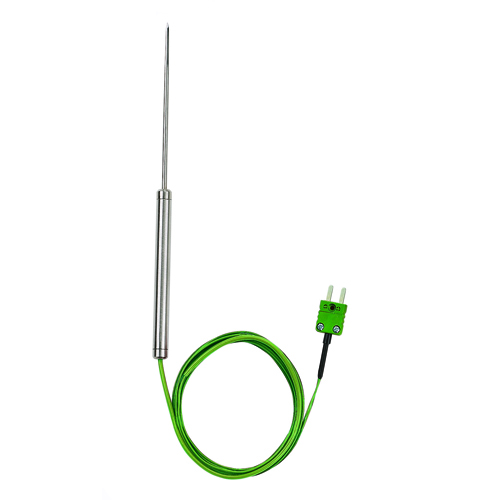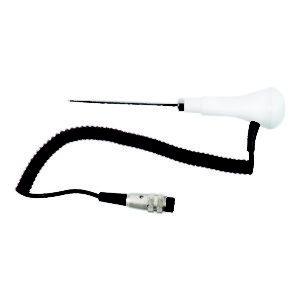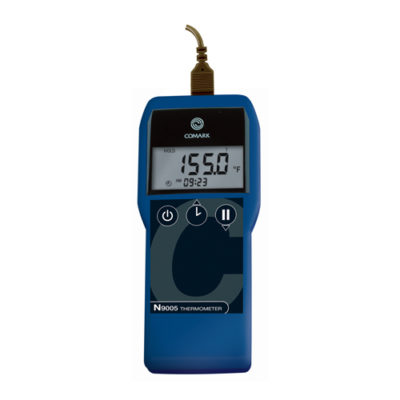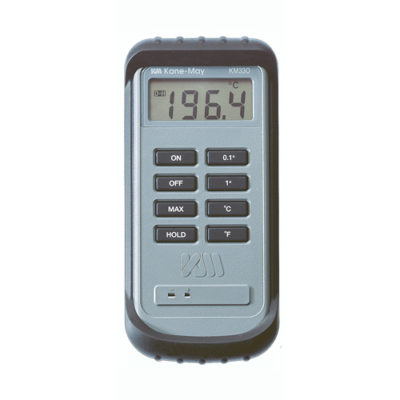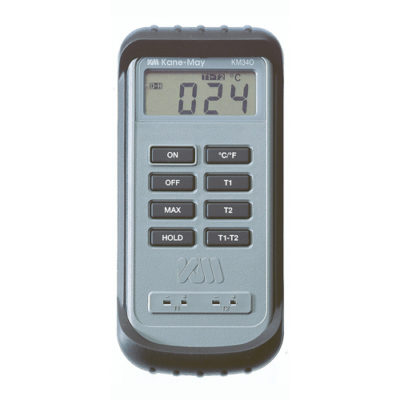Oven Meat Penetration Probe
Part No: PK23M (3060351)The PK23M Oven Meat Penetration Probe is designed for checking meat and food temperatures during cooking. It is fitted with a 2.5m lead.
- Temperature Range: -58°F to +482°F / -50°C to +250°C
- Sensor Type: Type K Thermocouple
- Connector Type: 2-Pin Sub-Miniature
- Warranty: 6 Months
Oven Meat Penetration Probe
The PK23M Oven Meat Penetration Probe is designed for checking meat and food temperatures during cooking. It is fitted with a 2.5m lead.

The PK23M Oven Meat Penetration Probe is fitted with a 2-Pin Sub-Miniature connector, to provide a quick and easy connection to your Data Logger.
Meat Thermometer Use
- Be sure the Thermometer stem is clean before using the Thermometer
- The meat you are roasting should be thawed entirely through before using the Thermometer
- Insert the thermometer stem into the roast or fowl being prepared, being sure the stem is inserted into the center of the meat and is not in contact with bone or gristle
- Pre-set the movable temperature indicator to the type of meat being grilled, roasted or baked
- When the internal temperature reaches the pre-set point on the dial the meat is done
Meat Temperatures
You cannot tell whether meat is safely cooked simply by looking at it. Any cooked, uncured red meats – including pork – can be pink, even when the meat has reached a safe internal temperature.
The U.S. Department of Health & Human Services recommends the following temperatures when cooking meat:
| Category | Food | Temperature (°F) | Rest Time |
| Ground Meat & Meat Mixtures | Beef, Pork, Veal, Lamb | 160 | None |
| Turkey, Chicken | 165 | None | |
| Fresh Beef, Veal, Lamb | Steaks, Roasts, Chops | 145 | 3 minutes |
| Poultry | Chicken & Turkey (Whole) | 165 | None |
| Poultry Breasts, Roasts | 165 | None | |
| Poultry Thighs, Legs, Wings | 165 | None | |
| Duck & Goose | 165 | None | |
| Pork and Ham | Fresh Pork | 145 | 3 minutes |
| Fresh Ham (Raw) | 145 | 3 minutes | |
| Precooked Ham (to Reheat) | 140 | None |
Technical Specifications
| Name | Value |
|---|---|
| Sensor Type | Type K Thermocouple |
| Connector Type | 2-Pin Sub-Miniature |
| Temperature Range | -50°C to 250°C / -58°F to +482°F |
| Response Time | 2.0 seconds |
| Stem Length | 100mm |
| Stem Diameter | 3.3mm |
| Lead Length | 2.5m |
| Lead Material | PTFE |
| Conformance to EU Regulation 1935/2004 ('Framework' Regulation on all Food Contact Materials) | Yes |
| Stem (Shaft) Material | 316L Stainless Steel |
| Warranty | 6 Months |
*You will need to Sign In to view additional content
Documentation
Articles / FAQs
| Name | Date |
|---|---|
General Care of Temperature ProbesGeneral Care of Temperature ProbesThe Probe is where most of the action with any Thermometer takes place. Almost every operation requires a Probe reading. The Probe should be treated with care in order to ensure best functioning and long life. We would recommend that you always have a spare, properly functioning Probe on hand, just in case the primary Probe breaks, or appears to be reading incorrectly. You should not stretch the coiled cable of any Probe, to reach an item to be measured. We would recommend instead that you ALWAYS move BOTH the Probe and the Thermometer, toward the food to be measured. This will help avoid unnecessary stress on the wires inside the Probe. You should not touch the coiled cable or Probe handle to hot surfaces, that might melt the protective coatings, which in turn could damage the Probe wires and render the Probe inoperable. You should not bend the tip of any Penetration Probe, as this too could break the wires and render the Probe inoperable. In general, Penetration Probes are designed for penetrating thawed food only and not for testing frozen food or containers or chipping ice.
You should clean the Probe and wire coil with a clean damp cloth, being VERY careful not to pull or stretch the coil and damage the wires inside. | 20th April 2015 |

